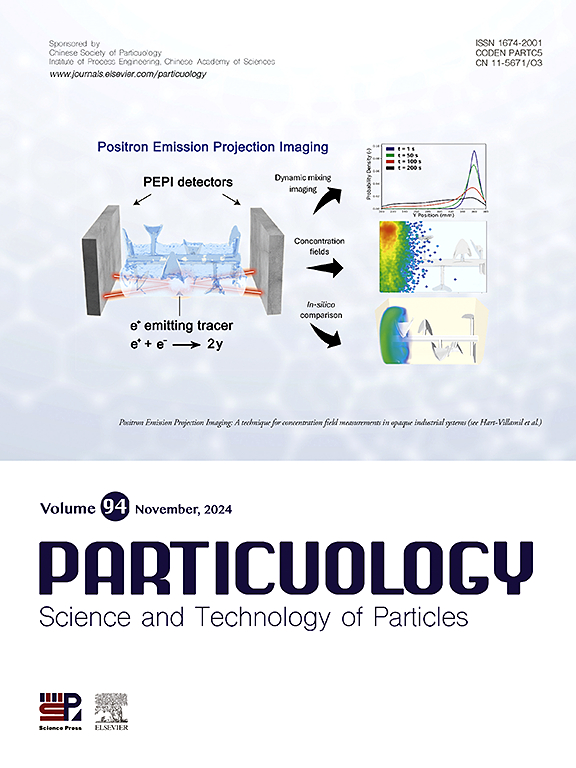Morphology control and crystal structure and properties analysis of FOX-7/HMX composite crystals prepared by rotary evaporation method
IF 4.1
2区 材料科学
Q2 ENGINEERING, CHEMICAL
引用次数: 0
Abstract
Enhancing the safety of high-energy explosives (EMs) is crucial for the secure handling of energetic materials during storage, transportation, and use. Compositing multiple energetic materials effectively enhances the insensitivity of explosives. This study used N,N-dimethylformamide (DMF) as a solvent in the rotary evaporation method to prepare 1,1-diamino-2,2-dinitroethene/1,3,5,7-tetranitro-1,3,5,7-tetraazacyclooctane (FOX-7/HMX) composite crystals. By varying the molar ratios of FOX-7 and HMX, this study investigated their effects on the morphology of the composite crystals, and the formation mechanism of the composite crystal was analyzed. The study characterized and tested the crystal structure, thermal decomposition, cook-off performance, and impact sensitivity of the composite crystal. The results indicate that at a 5:5 M ratio of FOX-7 to HMX, the compound degree is 90.79%, and FOX-7 exhibits uniform adhering to the surface of the HMX crystal. FT-IR and XRD patterns analyses revealed shifts in the absorption peak of the composite crystal and the characteristic peak of the XRD curve. FOX-7 crystals were embedded on the surface of HMX crystals, forming a co-crystal layer and altering the crystal structure. Differential scanning calorimetry tests demonstrate that the thermal decomposition temperature of FOX-7/HMX composite crystals is 1.77 °C higher than the raw FOX-7, and during the cook-off test, the composite crystal reaction level is combustion, accompanied by an increase in characteristic drop height to 62.6 cm, indicating improved thermal stability and impact safety.

旋转蒸发法制备FOX-7/HMX复合晶体的形貌控制及晶体结构与性能分析
提高高能炸药(EMs)的安全性对于高能材料在储存、运输和使用过程中的安全处理至关重要。多种含能材料的复合有效地提高了炸药的不敏感性。本研究以N,N-二甲基甲酰胺(DMF)为溶剂,采用旋转蒸发法制备了1,1-二氨基-2,2-二硝基乙烯/1,3,5,7-四硝基-1,3,5,7-四氮杂环辛烷(FOX-7/HMX)复合晶体。通过改变FOX-7和HMX的摩尔比,研究了它们对复合晶体形貌的影响,并分析了复合晶体的形成机理。本研究对复合晶体的晶体结构、热分解、烧蚀性能和冲击灵敏度进行了表征和测试。结果表明:当FOX-7与HMX的M比为5:5时,复合度为90.79%,FOX-7在HMX晶体表面呈现均匀粘附;FT-IR和XRD谱图分析表明,复合晶体的吸收峰和XRD曲线特征峰发生了位移。FOX-7晶体嵌入HMX晶体表面,形成共晶层,改变晶体结构。差示扫描量热法测试表明,FOX-7/HMX复合晶体的热分解温度比原料FOX-7高1.77℃,在烹煮试验中,复合晶体的反应级别为燃烧,特征落差高度增加到62.6 cm,表明热稳定性和冲击安全性得到了提高。
本文章由计算机程序翻译,如有差异,请以英文原文为准。
求助全文
约1分钟内获得全文
求助全文
来源期刊

Particuology
工程技术-材料科学:综合
CiteScore
6.70
自引率
2.90%
发文量
1730
审稿时长
32 days
期刊介绍:
The word ‘particuology’ was coined to parallel the discipline for the science and technology of particles.
Particuology is an interdisciplinary journal that publishes frontier research articles and critical reviews on the discovery, formulation and engineering of particulate materials, processes and systems. It especially welcomes contributions utilising advanced theoretical, modelling and measurement methods to enable the discovery and creation of new particulate materials, and the manufacturing of functional particulate-based products, such as sensors.
Papers are handled by Thematic Editors who oversee contributions from specific subject fields. These fields are classified into: Particle Synthesis and Modification; Particle Characterization and Measurement; Granular Systems and Bulk Solids Technology; Fluidization and Particle-Fluid Systems; Aerosols; and Applications of Particle Technology.
Key topics concerning the creation and processing of particulates include:
-Modelling and simulation of particle formation, collective behaviour of particles and systems for particle production over a broad spectrum of length scales
-Mining of experimental data for particle synthesis and surface properties to facilitate the creation of new materials and processes
-Particle design and preparation including controlled response and sensing functionalities in formation, delivery systems and biological systems, etc.
-Experimental and computational methods for visualization and analysis of particulate system.
These topics are broadly relevant to the production of materials, pharmaceuticals and food, and to the conversion of energy resources to fuels and protection of the environment.
 求助内容:
求助内容: 应助结果提醒方式:
应助结果提醒方式:


